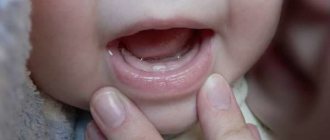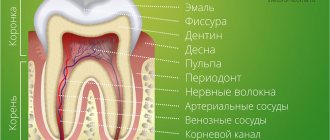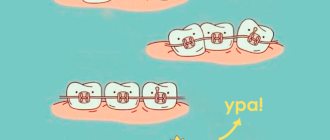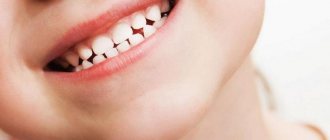Quite often, parents wonder how long it takes for babies to teethe? The eruption of the first teeth in infants is a serious process that can cause a lot of difficulties and troubles. The whole process may proceed differently for each child. Some children spend nights awake in pain, while others experience their first tooth appearing unnoticed. Why this happens, how long it takes for teeth to erupt after the gums swell and how to help the baby survive the painful process will be discussed in our article today.
Timing of baby teeth eruption
It is impossible to say unequivocally that the first teeth appear at any one specific time. The process is different for each child. Therefore, the timing of the eruption of milk units in infants differs. This depends on both external and internal factors. The following factors have an active influence:
- Hereditary.
- Climate.
- Baby's diet.
- Gender of the child.
According to statistics, in girls the process occurs earlier than in boys by about a month and a half. For most babies, teething begins at six months. But even if the first tooth appeared at ten months, this does not indicate pathology. Most often, the lower front teeth erupt first, followed by the upper incisors. Milk units appear in pairs. Therefore, if you find the first tooth, this indicates that the second one will come out within a few days. It is also possible for four teeth to erupt at once.
After the first two teeth have appeared, the next ones will erupt in about two months. Typically, a baby celebrates his first birthday with four teeth in each row. Some babies only have one tooth by the age of twelve months, and this is also normal. But if by the age of one year the child does not have a single tooth at all, there is no swelling of the gums, it is worth showing the baby to a pediatric specialist. Why does a one-year-old child not have teeth?
- growth retardation due to rickets;
- no rudiments of teeth (edentia);
- lack of essential vitamins and microelements;
- problems with the thyroid gland.
In rare cases, babies are already born with teeth. Dentists recommend removing them so that the mother can breastfeed the baby normally. If the endocrine system is disrupted, milk units may erupt early, for example, at four months.
What is the danger of premature loss of baby teeth?
Trauma, caries and other dental diseases can cause the loss of a baby tooth. In place of the tooth there remains a “gap” in the dentition, which can cause significant disturbances in the formation of a permanent bite:
- crowding or crowding of teeth;
- dystopia of the tooth, when it erupts outside the dentition;
- horizontal overjet or excessive overlap of the lower front teeth with the upper ones;
- overbite or changing the distance between the chewing surfaces of opposing teeth in the vertical plane.
At the initial stage, changes may be minor. However, over time they begin to progress rapidly.
If a baby tooth is lost prematurely, then it is advisable to “close” the defect in the dentition that has formed in its place with a removable denture. Most often, so-called immediate dentures are used, which in private conversations dentists may call “clothespins.”
It is not only the fact of tooth loss that matters, but also the reason why it happened. Preventing childhood injuries is a good thing, but not always 100% effective. But in terms of prevention and treatment, caries is much simpler. If you consult a doctor in a timely manner, initial changes in the enamel can be eliminated with the help of special gels and varnishes, and emerging carious cavities can be cleaned and filled without the use of a drill.
It is not recommended to leave caries unattended, as these are not just black spots on the teeth. This is primarily a breeding ground for pathogenic microorganisms, an infection whose toxic effect on the body can lead to serious consequences. A reliable connection between caries and pathology of the kidneys and digestive system has been established. Changing teeth cannot solve the problem of caries in a child. Milk and permanent teeth “neighbor” each other for a long time, which increases the likelihood of damage to permanent teeth by the carious process.
How long does it take for infants to erupt teeth?
A common question among new parents is: how long does it take for a baby to teethe? Despite the fact that modern medicine uses advanced equipment and fresh scientific discoveries, no doctor can predict how long it takes for infants to erupt their first teeth. Each baby will begin to develop teeth at different times. This is a highly individual process that is influenced by many factors. If you notice slight redness and swelling of the gums, it means that the first tooth will appear within one week to two months. It will take the tooth 3 to 7 days to break through the gum. The teething process is accompanied by discomfort and pain. While the tooth passes through the tissue, the baby feels unpleasant itching and pain.
Inflamed gums can also bother a child. Complications often arise due to infection. During this period, parents should pay close attention to the child’s condition. How long it takes for children to cut teeth depends solely on the individual characteristics of the baby’s body. Since the upper teeth take a long time to erupt, children will have the hardest time and the most pain when the canines of the upper jaw erupt. Remember, no matter how much you would like to help your child, under no circumstances should you give infants adult painkillers. The content of active substances in high concentrations causes allergic reactions and other serious side effects in children. To ensure that everything goes as painlessly and safely as possible for the baby, you should consult a pediatrician.
When do baby teeth start falling out?
Baby teeth begin to form while the baby is still in the mother's womb. Moreover, their number is not 32, as in an adult, but only 20. Baby teeth usually fully erupt by the age of 2. At the age of approximately 6 years, the replacement of baby teeth with permanent teeth begins to occur. In this case, 20 existing teeth fall out, and the remaining 12 erupt. This usually happens in the following order:
- The deciduous incisors are usually the first to fall out. The roots of the teeth begin to thin out, and when the baby reaches a certain age, the incisor falls out. For central incisors it is 6 years, for lateral incisors - 7 years.
- Then the molars begin to fall out. These baby teeth are divided into first and second teeth. Loss of first molars occurs between 7 and 10 years of age. The second molars are the last to fall out, between the ages of 9 and 13.
- In the interval between the loss of the first and second molars, loosening and loss of the upper and lower canines occurs. This occurs between the ages of 9 and 11 years.
It should be remembered that the process of replacing baby teeth with molars is individual, and the indicated timing is not necessarily suitable for all children.
How to determine that a tooth is already erupting
Signs of the upcoming eruption of the first tooth can be detected long before it appears in the oral cavity. In about two to three weeks, mothers begin to notice the corresponding symptoms:
- The baby becomes very restless and capricious.
- The baby does not latch onto the breast, cries, and has difficulty falling asleep.
- You may notice heavy salivation.
- The gums become swollen and then reddened.
Often the teething process drags on for several months. The baby puts toys into his mouth to scratch his gums. Knowing what alarming symptoms there may be, parents can always help:
- The temperature rises to low-grade. If the temperature exceeds 38 degrees and persists for more than three days, you will need to consult a pediatrician.
- The chair has changed. Pediatricians explain this by a change in diet, since babies refuse food during teething.
- A cough appeared. Cough is often the result of a weakened immune system. With inflammatory processes and an increased number of pathogens, a runny nose or cough may appear. If you experience sputum production, shortness of breath, or wheezing, you will need the help of a doctor.
- The appearance of a specific “metal” odor from the mouth. The gums may bleed slightly when teething, hence the odor.
You should definitely consult a doctor if your baby's teething process is accompanied by an infectious disease. It is impossible to say for sure how long it takes for the first teeth to erupt. But parents must be prepared for any changes. If you notice the first symptoms of teething, you can immediately consult a pediatrician who will prescribe medications to alleviate the baby’s condition.
Teething
Why do fangs cause the greatest discomfort and pain during teething? This condition is primarily due to the fact that the roots of the canine teeth of the upper jaw are located deep, near the optic nerves. When these nerves are irritated, pain occurs. To the symptoms of eruption of the upper canines, you can also add signs of conjunctivitis. Statistically, these teeth take much longer to appear than other units. It may take up to a year and a half until the fang comes out completely. The order of appearance is as follows: the upper canines appear first, and then the lower ones. Mothers should know that at any moment the baby’s body temperature can rise to 38 degrees.
Timing of teething
The wait is especially long after the removal of chewing temporary teeth, which are usually the first to suffer from caries and its complications. Often, parents frivolously insist on removing molar baby teeth, blithely declaring: permanent ones will grow in!
But the process of changing bites develops according to strict laws. Follicles (buds) of temporary and permanent teeth are located in two rows in each jaw of a newborn, going through successive stages of formation and mineralization before eruption. It is impossible to speed up these stages by any means.
The milky roots gradually dissolve, and permanent follicles are pushed out in their place by the coronal part. And only after the formation is completed, permanent teeth appear above the surface of the gum. The first to erupt is the so-called “sixth tooth” - the first molar, which parents often mistake for temporary, and therefore do not treat its carious lesions. This tooth has an important function - it determines the height of the permanent bite and the place of the other “brothers” in the dentition.
We give approximate dates for the appearance of permanent teeth to make it easier for parents to navigate the normality of the change process:
- first incisor - 6-7 years;
- second incisor - 7-8 years;
- fang - 9-11 years;
- first small root - 8-10 years;
- second small root - 11-12 years;
- first major molar - 6 years;
- second major molar - 13-14 years.
Small molars replace primary chewing teeth. If a temporary tooth was removed at the age of 6-7 years, which is not uncommon, then the child is deprived of the ability to fully chew food for as long as 5-6 years. Therefore, it is so important to promptly treat caries of milk precursors.
Ways to alleviate the condition
Parents will not be able to speed up the process of the appearance of the first teeth, but they can temporarily alleviate the child’s condition. In most cases, gum massage helps. Please note that movements should be soft and careful. If you find severe inflammation, you need to wipe the mucous membrane with peroxide or decoctions of medicinal herbs, which have an anti-inflammatory effect. Decoctions of chamomile and oak bark help well. The water should be at room temperature.
You can buy a special silicone cap at the pharmacy, which has thin brushes on one side and thick brushes on the other. This accessory is used as a gum massager. Once baby teeth emerge, they can be used for oral hygiene. Talk to your pediatrician about what dental gel you can use. These tools have proven themselves well:
- Dentinox.
- Kalgel.
- Baby doctor.
- Holisal.
Contains lidocaine or menthol. Gels can cool the painful area. The effect time is approximately twenty minutes. Lidocaine should be treated with the utmost care, since this substance can cause allergies. Despite the fact that gels are effective, they should never be abused. It is recommended to use a maximum of five times a day.
Another good option that will help relieve teething symptoms is special toys. They are called “teethers” and come in two types: without liquid and with liquid. If the accessory is filled with liquid, it must be kept in the refrigerator for a certain time and then given to the child. When the baby chews on the teether, the textured side massages, and the cooled liquid relieves pain from the gums. Due to increased salivation, the baby's chin will be constantly wet. Use soft, clean wipes to avoid the development of “seizing.”
Do not injure the gums and give your baby pieces of crackers or sugar. Doctors do not recommend such methods. Parents should understand that it is impossible to accurately predict the sequence and timing of tooth eruption. Moreover, this will in no way affect the quality of the teeth. But there are situations when parents worry why the child’s teeth are not cutting through for a long time. If the baby is already one year old and the first tooth has not appeared, you need to contact a specialist.
What mistakes should not be made?
Every caring mother and attentive father strive with all their might to make it easier for the child to survive the teething process. But sometimes panic forces adults to make serious mistakes. Below we will look at what you should absolutely not do:
- Cool the gums too often. Cold helps, but you should not constantly be exposed to cold, as this can cause the development of a cold.
- Do not give babies crackers, refined sugar and other foods that can scratch the mucous membranes. You can prepare a chilled teether for your baby.
- Soda solution instead of gels. Don't experiment. It is better to consult a pediatrician who will recommend the optimal dental gel.
It is difficult to say for sure how long it takes for babies to erupt teeth. But parents during this period should be prepared for any turn of events.











